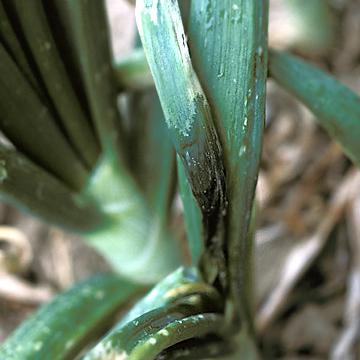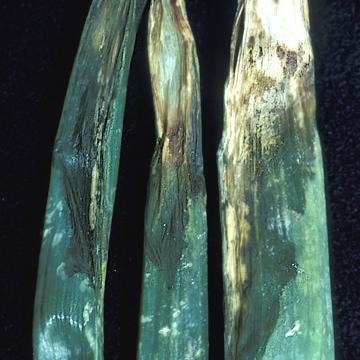DISEASE: Apple proliferation
HOST: Apple
Spring form of the adult black-veined psyllid, Cacopsylla melanoneura, a vector of apple proliferation. In winter, adults are more greenish in color.
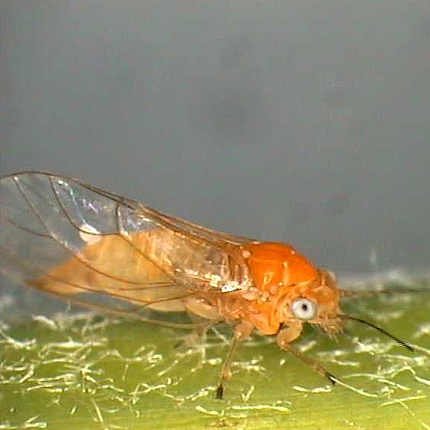
Apple proliferation | Apple
DISEASE: Apple proliferation
HOST: Apple (Malus domestica)
PATHOGEN: 'Candidatus Phytoplasma mali'
PATHOGEN SYNONYM: Phytoplasma Apple proliferation group
SOURCE: M. Wolf, W. Schweigkofler
DISEASE: Apple proliferation
HOST: Apple
Typical apple proliferation symptom of witches'-broom resulting from suppression of apical dominance and growth of dormant axillary buds. Branches are not usually bent down as shown here.

Apple proliferation | Apple
DISEASE: Apple proliferation
HOST: Apple (Malus domestica)
PATHOGEN: 'Candidatus Phytoplasma mali'
PATHOGEN SYNONYM: Phytoplasma Apple proliferation group
SOURCE: M. Wolf, W. Schweigkofler
DISEASE: Aster yellows
HOST: Onion
Infected plants with yellowish, malformed leaves.

Aster yellows | Onion
DISEASE: Aster yellows
HOST: Onion (Allium cepa)
PATHOGEN: 'Candidatus Phytoplasma asteris'
PATHOGEN SYNONYM: Phytoplasma Aster yellows group
SOURCE: R. Rowe
DISEASE: Aster yellows
HOST: Onion
Onion flower with unusual symptoms (left) compared with healthy inflorescence (right). Flowers are distorted and often have abnormally long pedicels. Young leaves may have yellow streaks or a general yellowing of basal portions.

Aster yellows | Onion
DISEASE: Aster yellows
HOST: Onion (Allium cepa)
PATHOGEN: 'Candidatus Phytoplasma asteris'
PATHOGEN SYNONYM: Phytoplasma Aster yellows group
SOURCE: R. Raabe
DISEASE: Bacterial flower stalk and leaf necrosis
HOST: Onion
Dark, rotted areas of stalk and leaves caused by systemic invasion of the pathogen.
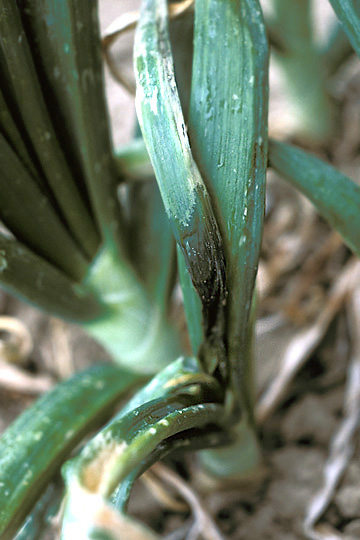
Bacterial flower stalk and leaf necrosis | Onion
DISEASE: Bacterial flower stalk and leaf necrosis
HOST: Onion (Allium cepa)
PATHOGEN: Pseudomonas marginalis pv. marginalis
SOURCE: S. Mohan
DISEASE: Bacterial flower stalk and leaf necrosis
HOST: Onion
Gray-brown rot of onion after inoculation. Disease starts as small, water-soaked lesions that later develop into slimy, gray-brown rot. The disease progresses downward from the stalk and may rot the entire bulb.
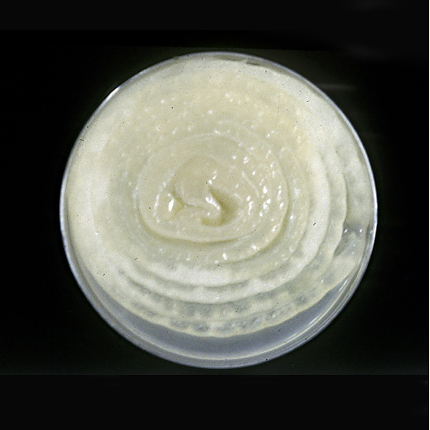
Bacterial flower stalk and leaf necrosis | Onion
DISEASE: Bacterial flower stalk and leaf necrosis
HOST: Onion (Allium cepa)
PATHOGEN: Pseudomonas marginalis pv. marginalis
SOURCE: R. Gitaitis
DISEASE: Bacterial flower stalk and leaf necrosis
HOST: Onion
Leaves with necrosis and rot. The common name for this disease is the same as those used for two other diseases. Also, another common name for this disease is bacterial soft rot.
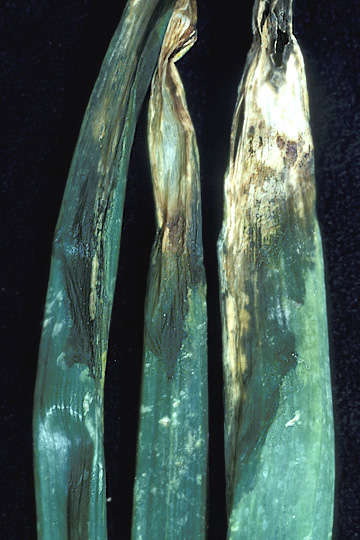
Bacterial flower stalk and leaf necrosis | Onion
DISEASE: Bacterial flower stalk and leaf necrosis
HOST: Onion (Allium cepa)
PATHOGEN: Pseudomonas marginalis pv. marginalis
SOURCE: S. Mohan
DISEASE: Bacterial leaf blight and stalk rot
HOST: Corn (Maize)
Corn husk leaves with brownish red streaks and blotches. The leaves turn brown but may later become gray or white. Symptoms vary depending upon genotype.

Bacterial leaf blight and stalk rot | Corn (Maize)
DISEASE: Bacterial leaf blight and stalk rot
HOST: Corn (Maize) (Zea mays)
PATHOGEN: Acidovorax avenae
PATHOGEN SYNONYM: Acidovorax avenae subsp. avenae
SOURCE: A. Alvarez
DISEASE: Bacterial leaf blight and stalk rot
HOST: Corn (Maize)
Leaves with whitish streaks.

Bacterial leaf blight and stalk rot | Corn (Maize)
DISEASE: Bacterial leaf blight and stalk rot
HOST: Corn (Maize) (Zea mays)
PATHOGEN: Acidovorax avenae
PATHOGEN SYNONYM: Acidovorax avenae subsp. avenae
SOURCE: R. Gitaitis






